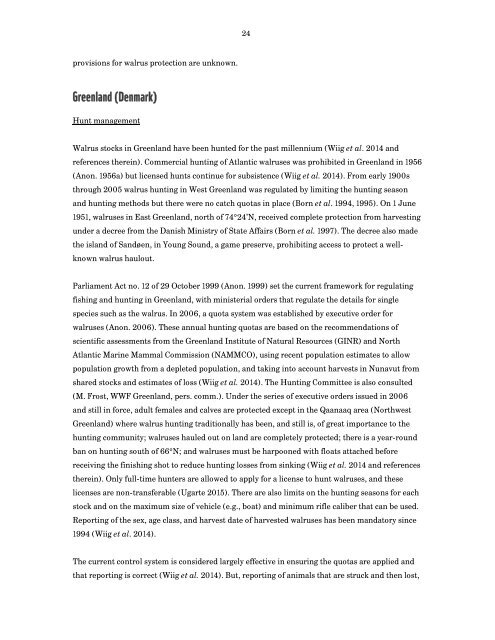The State of Circumpolar Walrus Populations
walrusreport
walrusreport
You also want an ePaper? Increase the reach of your titles
YUMPU automatically turns print PDFs into web optimized ePapers that Google loves.
24<br />
provisions for walrus protection are unknown.<br />
Greenland (Denmark)<br />
Hunt management<br />
<strong>Walrus</strong> stocks in Greenland have been hunted for the past millennium (Wiig et al. 2014 and<br />
references therein). Commercial hunting <strong>of</strong> Atlantic walruses was prohibited in Greenland in 1956<br />
(Anon. 1956a) but licensed hunts continue for subsistence (Wiig et al. 2014). From early 1900s<br />
through 2005 walrus hunting in West Greenland was regulated by limiting the hunting season<br />
and hunting methods but there were no catch quotas in place (Born et al. 1994, 1995). On 1 June<br />
1951, walruses in East Greenland, north <strong>of</strong> 74°24’N, received complete protection from harvesting<br />
under a decree from the Danish Ministry <strong>of</strong> <strong>State</strong> Affairs (Born et al. 1997). <strong>The</strong> decree also made<br />
the island <strong>of</strong> Sandøen, in Young Sound, a game preserve, prohibiting access to protect a wellknown<br />
walrus haulout.<br />
Parliament Act no. 12 <strong>of</strong> 29 October 1999 (Anon. 1999) set the current framework for regulating<br />
fishing and hunting in Greenland, with ministerial orders that regulate the details for single<br />
species such as the walrus. In 2006, a quota system was established by executive order for<br />
walruses (Anon. 2006). <strong>The</strong>se annual hunting quotas are based on the recommendations <strong>of</strong><br />
scientific assessments from the Greenland Institute <strong>of</strong> Natural Resources (GINR) and North<br />
Atlantic Marine Mammal Commission (NAMMCO), using recent population estimates to allow<br />
population growth from a depleted population, and taking into account harvests in Nunavut from<br />
shared stocks and estimates <strong>of</strong> loss (Wiig et al. 2014). <strong>The</strong> Hunting Committee is also consulted<br />
(M. Frost, WWF Greenland, pers. comm.). Under the series <strong>of</strong> executive orders issued in 2006<br />
and still in force, adult females and calves are protected except in the Qaanaaq area (Northwest<br />
Greenland) where walrus hunting traditionally has been, and still is, <strong>of</strong> great importance to the<br />
hunting community; walruses hauled out on land are completely protected; there is a year-round<br />
ban on hunting south <strong>of</strong> 66°N; and walruses must be harpooned with floats attached before<br />
receiving the finishing shot to reduce hunting losses from sinking (Wiig et al. 2014 and references<br />
therein). Only full-time hunters are allowed to apply for a license to hunt walruses, and these<br />
licenses are non-transferable (Ugarte 2015). <strong>The</strong>re are also limits on the hunting seasons for each<br />
stock and on the maximum size <strong>of</strong> vehicle (e.g., boat) and minimum rifle caliber that can be used.<br />
Reporting <strong>of</strong> the sex, age class, and harvest date <strong>of</strong> harvested walruses has been mandatory since<br />
1994 (Wiig et al. 2014).<br />
<strong>The</strong> current control system is considered largely effective in ensuring the quotas are applied and<br />
that reporting is correct (Wiig et al. 2014). But, reporting <strong>of</strong> animals that are struck and then lost,


